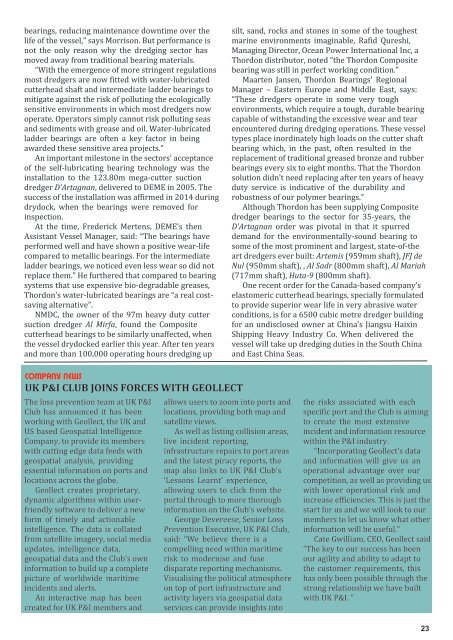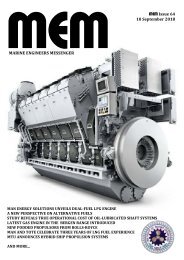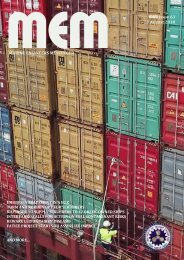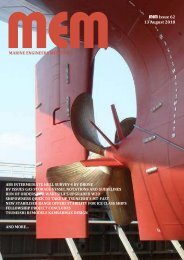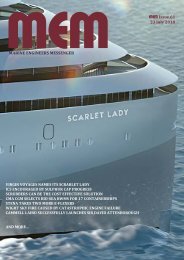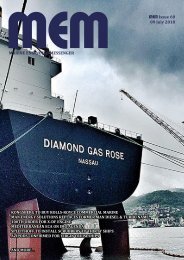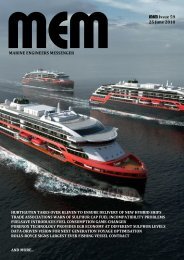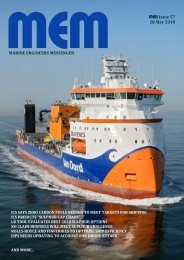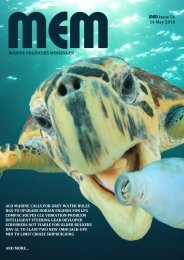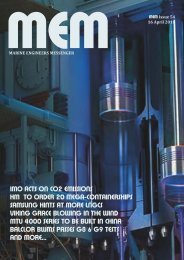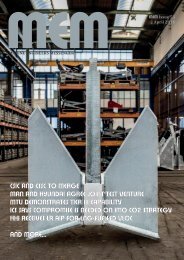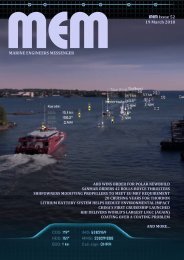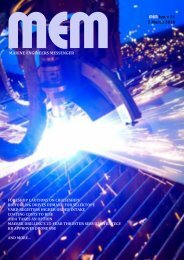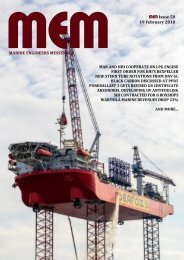You also want an ePaper? Increase the reach of your titles
YUMPU automatically turns print PDFs into web optimized ePapers that Google loves.
earings, reducing maintenance downtime over the<br />
life of the vessel,” says Morrison. But performance is<br />
not the only reason why the dredging sector has<br />
moved away from traditional bearing materials.<br />
“With the emergence of more stringent regulations<br />
most dredgers are now fitted with water-lubricated<br />
cutterhead shaft and intermediate ladder bearings to<br />
mitigate against the risk of polluting the ecologically<br />
sensitive environments in which most dredgers now<br />
operate. Operators simply cannot risk polluting seas<br />
and sediments with grease and oil. Water-lubricated<br />
ladder bearings are often a key factor in being<br />
awarded these sensitive area projects.”<br />
An important milestone in the sectors’ acceptance<br />
of the self-lubricating bearing technology was the<br />
installation to the 123.80m mega-cutter suction<br />
dredger D’Artagnan, delivered to DEME in 2005. The<br />
success of the installation was affirmed in 2014 during<br />
drydock, when the bearings were removed for<br />
inspection.<br />
At the time, Frederick Mertens, DEME’s then<br />
Assistant Vessel Manager, said: “The bearings have<br />
performed well and have shown a positive wear-life<br />
compared to metallic bearings. For the intermediate<br />
ladder bearings, we noticed even less wear so did not<br />
replace them.” He furthered that compared to bearing<br />
systems that use expensive bio-degradable greases,<br />
Thordon’s water-lubricated bearings are “a real costsaving<br />
alternative”.<br />
NMDC, the owner of the 97m heavy duty cutter<br />
suction dredger Al Mirfa, found the Composite<br />
cutterhead bearings to be similarly unaffected, when<br />
the vessel drydocked earlier this year. After ten years<br />
and more than 100,000 operating hours dredging up<br />
silt, sand, rocks and stones in some of the toughest<br />
marine environments imaginable, Rafid Qureshi,<br />
Managing Director, Ocean Power International Inc, a<br />
Thordon distributor, noted “the Thordon Composite<br />
bearing was still in perfect working condition.”<br />
Maarten Jansen, Thordon Bearings’ Regional<br />
Manager – Eastern Europe and Middle East, says:<br />
“These dredgers operate in some very tough<br />
environments, which require a tough, durable bearing<br />
capable of withstanding the excessive wear and tear<br />
encountered during dredging operations. These vessel<br />
types place inordinately high loads on the cutter shaft<br />
bearing which, in the past, often resulted in the<br />
replacement of traditional greased bronze and rubber<br />
bearings every six to eight months. That the Thordon<br />
solution didn’t need replacing after ten years of heavy<br />
duty service is indicative of the durability and<br />
robustness of our polymer bearings.”<br />
Although Thordon has been supplying Composite<br />
dredger bearings to the sector for 35-years, the<br />
D’Artagnan order was pivotal in that it spurred<br />
demand for the environmentally-sound bearing to<br />
some of the most prominent and largest, state-of-the<br />
art dredgers ever built: Artemis (959mm shaft), JFJ de<br />
Nul (950mm shaft), , Al Sadr (800mm shaft), Al Mariah<br />
(717mm shaft), Huta-9 (800mm shaft).<br />
One recent order for the Canada-based company’s<br />
elastomeric cutterhead bearings, specially formulated<br />
to provide superior wear life in very abrasive water<br />
conditions, is for a 6500 cubic metre dredger building<br />
for an undisclosed owner at China’s Jiangsu Haixin<br />
Shipping Heavy Industry Co. When delivered the<br />
vessel will take up dredging duties in the South China<br />
and East China Seas.<br />
COMPANY NEWS<br />
UK P&I CLUB JOINS FORCES WITH GEOLLECT<br />
The loss prevention team at UK P&I<br />
Club has announced it has been<br />
working with Geollect, the UK and<br />
US based Geospatial Intelligence<br />
Company, to provide its members<br />
with cutting edge data feeds with<br />
geospatial analysis, providing<br />
essential information on ports and<br />
locations across the globe.<br />
Geollect creates proprietary,<br />
dynamic algorithms within userfriendly<br />
software to deliver a new<br />
form of timely and actionable<br />
intelligence. The data is collated<br />
from satellite imagery, social media<br />
updates, intelligence data,<br />
geospatial data and the Club’s own<br />
information to build up a complete<br />
picture of worldwide maritime<br />
incidents and alerts.<br />
An interactive map has been<br />
created for UK P&I members and<br />
allows users to zoom into ports and<br />
locations, providing both map and<br />
satellite views.<br />
As well as listing collision areas,<br />
live incident reporting,<br />
infrastructure repairs to port areas<br />
and the latest piracy reports, the<br />
map also links to UK P&I Club’s<br />
‘Lessons Learnt’ experience,<br />
allowing users to click from the<br />
portal through to more thorough<br />
information on the Club’s website.<br />
George Devereese, Senior Loss<br />
Prevention Executive, UK P&I Club,<br />
said: “We believe there is a<br />
compelling need within maritime<br />
risk to modernise and fuse<br />
disparate reporting mechanisms.<br />
Visualising the political atmosphere<br />
on top of port infrastructure and<br />
activity layers via geospatial data<br />
services can provide insights into<br />
the risks associated with each<br />
specific port and the Club is aiming<br />
to create the most extensive<br />
incident and information resource<br />
within the P&I industry.<br />
“Incorporating Geollect’s data<br />
and information will give us an<br />
operational advantage over our<br />
competition, as well as providing us<br />
with lower operational risk and<br />
increase efficiencies. This is just the<br />
start for us and we will look to our<br />
members to let us know what other<br />
information will be useful.”<br />
Cate Gwilliam, CEO, Geollect said<br />
“The key to our success has been<br />
our agility and ability to adapt to<br />
the customer requirements, this<br />
has only been possible through the<br />
strong relationship we have built<br />
with UK P&I. ”<br />
23


